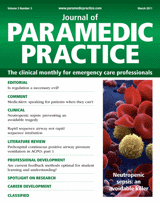References
Getting more AEDs in public places
Sudden cardiac arrest (SCA) is a leading cause of premature death. In the UK alone, approximately 30 000 people sustain cardiac arrest outside hospital and are treated by emergency medical services (EMS) each year (Pell et al, 2003). However, many SCA victims can be saved by bystanders who recognise what has happened, summon the ambulance service as soon as possible, perform basic CPR and use an AED to provide a high-energy electric shock to restore the heart's normal rhythm (Resuscitation Council (UK) and British Heart Foundation, 2013).
It has been shown that a strong predictor of SCA survival is the interval from collapse of the patient to defibrillation (Valenzuela et al, 1997). While this generally applies to defibrillation as carried out by healthcare professionals—from emergency physicians, to paramedics, to first responders—it also extends to defibrillation carried out by the layperson (Rea and Page, 2010). The introduction of public access defibrillation (PAD) programmes has produced positive results. One US study, which looked at a prospective series of cases of SCA in casinos, attended to by security officers instructed in the use of AEDs, recorded survival rates as high as 74% (Valenzuela et al, 2000).
Subscribe to get full access to the Journal of Paramedic Practice
Thank you for visiting the Journal of Paramedic Practice and reading our archive of expert clinical content. If you would like to read more from the only journal dedicated to those working in emergency care, you can start your subscription today for just £48.
What's included
-
CPD Focus
-
Develop your career
-
Stay informed

